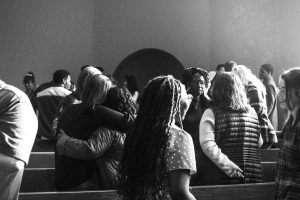The show must go on
Students resilient in spite of MODE Fashion Show cancellation
May 14, 2020
Models typically walk down a runway showcasing the hard work of designers and stylists at Seattle Pacific University’s MODE Fashion Show. Months of preparation by the designers and stylists are supposed to garner the recognition these students deserve.
This year, things are different as events across campus have been canceled, forcing fashion students to figure out an alternative way to present their work.
As a result, those participating in the show have decided to make a magazine, which will feature the students modelling their own work as well as photos of the production process for each piece, such as moodboards. It’s release date is currently undecided.
This solution presents its own problems, but the students are trying their best to deal with the obstacles presented to them.
“They are making lemonade out of these lemons. They are working so hard through all of this helplessness and sometimes hopelessness,” Adjunct Professor of Apparel and Merchandising Beb Santo said in a phone call.
Students in the MODE Fashion Show worked hard to jump over the hurdles that came with this new format.
Third year apparel design, costume design and production major Emily Barker described how far along in the process she was before she received news of the cancellation.
“I’d done all my background research and decided on my mood board and story. I’d done all my sketches. I think, at that point, I bought all my fabrics, got model measurements and I was in the process of pattern making so I was making patterns to fit these models I had,” Barker said on a phone call.
This meant that Barker was ready to start making her designs. Then, COVID-19 began shutting down events and she started to suspect the worst, stopping work on her project temporarily.
This foresight led her to produce her clothing to fit herself instead of models.
Some students, though, found this switch to be more difficult, causing some to drop out of the show, Santo said.
“We had a few that had to opt out of the fashion show due to the situation they’re in back at home … there are things that happen mentally, emotionally, psychologically that are occuring,” Santo said.
This included problems with being out of work, which has made it difficult for some students to obtain the materials necessary for creating their pieces.
It has also been difficult for stylists, according to Santo, as they were limited to purchasing materials from thrift stores to create their looks and these stores are now closed .
To combat this, students were allowed, before they left campus, to take a look at the archive of fabrics the department has collected over the years from donations. This was not a one size fits all solution, though, since many were not able to find fabrics that suited their pieces.
Senior apparel design major Teylor Rohrbaugh described this struggle of finding fabrics.
“It is so tactile and I am very specific on the fabrics I use. I need to be able to touch it … so buying stuff online is really difficult because I can’t touch it,” Rohrbaugh said on a phone call.
Luckily, Rohrbaugh planned on modeling her own design. She also bought some materials before the school shut down.
“My collection originally was going to reuse certain things like buttons and zippers so I bought a couple things from thrift shops in December. So now, because I don’t have access to a lot of materials, I’m utilizing those clothes more as just materials for my collection than I originally plan,” Rohrbaugh said.
Despite all these struggles, Rohrbaugh expressed appreciation for it as a creative outlet during this hard time.
“I’m definitely treasuring the time I am working on this stuff more,” Rohrbaugh said.
“It was more of a nuisance earlier in the year because I was so focused on class and work but now I actually have time to work on this, and it’s calming.”


























































































